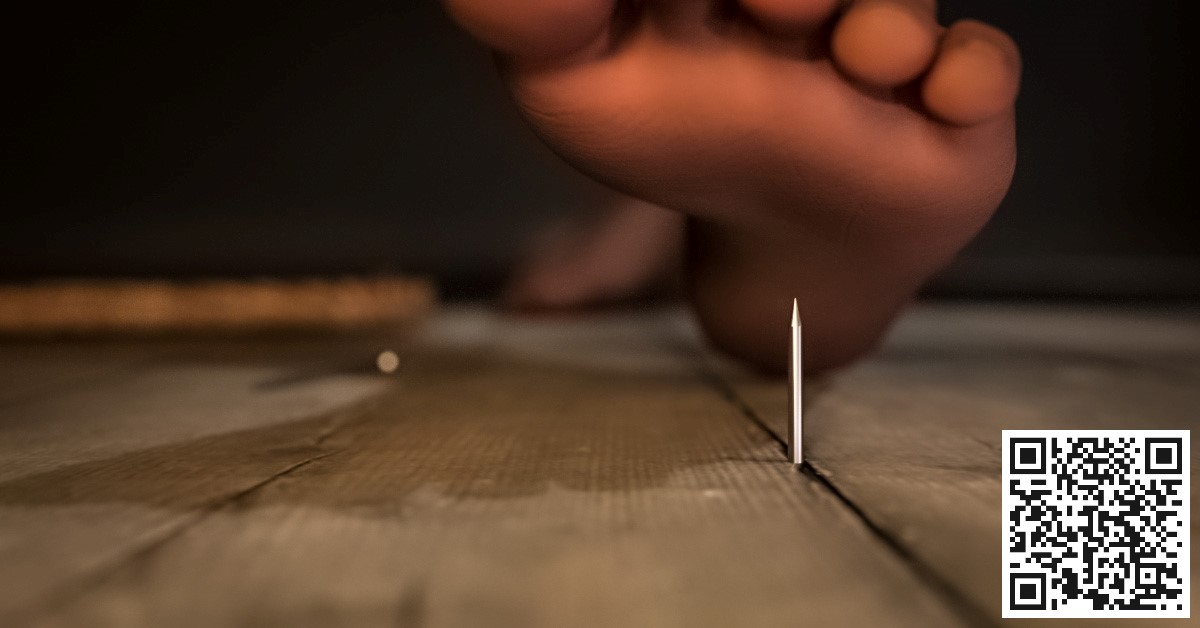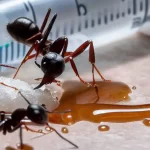Tetanus (pronounced: teh·tuh·nuhs), also called “lockjaw” is an infection that causes painful muscle contractions.
The infection starts when a bacterium, Clostridium tetani, enters the body usually through a puncture wound or deep cut.
In line with our tradition, I present all the important information about tetanus using poetry; I have written it in two parts:
- First, a poem in the form of a recollection by a person that survived tetanus.
- Second, a line-by-line explanation of the poem.
If you prefer audiovisuals, tap on the play button below:
A case of Tetanus
I once had a penetrating injury,
stepped on a nail during carpentry
took a break, examined the puncture
rubbed some dung and tied, culture
In ten days, my face was a permanent grin,
like one poisoned with strychnine;
gradually, intense waves of spasms
rocked my body, in discordant rhythms
Doctor said: “A case of tetanus”;
all else was monotonous
His face looked deathly grim,
as he mouthed “chance of survival, slim”
thoughts of those days I still dread,
when my heels reached for back of my head,
contorted like a doll, forced to persevere
in the hands of a sadistic puppeteer
I was kept in a sealed, dark room;
little light or sound and boom!
another round of endless torture
contractions so intense I had fracture
My heart would race like an escaping fugitive’s;
twenty-four hours on restraints and sedatives,
burning endlessly like a radiator
knocked out and placed on a ventilator
Weeks passed and I got better,
a neck scar and strange gait as reminder
should have been prompt with prevention
should have been diligent with immunization
Tetanus, explained
Stanza 1 (the puncture)
“I once had a penetrating injury,” … “stepped on a nail during carpentry” (stanza 1, lines 1 & 2)
The bacterium that causes tetanus (Clostridium tetani or C. tetani) is present everywhere, from soil to feces to saliva. It is able to survive harsh conditions, outside a living host by forming ‘endospores‘.
‘Endospores’ are like tiny seeds, which you cannot see except with a microscope. Other bacteria that produce endospores include those that cause anthrax (Bacillus anthracis) and botulism (Clostridium botulinum).
Tetanus bacteria endospores enter into the body through puncture wounds, penetrating injuries or deep cuts, for example, when you step on a rusty nail.
NOTE: Rust does not cause tetanus; rather, the rough surfaces of metals that are rusty, provide a hiding place for Tetanus bacterium endospores.
Once the environment is favorable, for example, inside a deep wound where the oxygen level is low, the endospores multiply.
“took a break, examined the puncture, … rubbed some dung and tied, culture” (stanza 1, lines 3 & 4)
The line: “rubbed some dung and tied, culture” is a pun, that is, it has 2 meanings:
First, there are various “cultures” and traditions regarding the management of wounds, for example, in some cultures people apply dung (feces) to the surfaces of wounds believing that it helps healing.
Second, a culture is a medium or environment that nurtures the growth of organisms.
Blood is a rich culture medium so when you add dung to a wound, you are essentially creating an enabling environment for the growth of organisms present in the ‘dung’.
Stanza 2 (signs and symptoms of tetanus)
“In ten days, my face was a permanent grin,” (stanza 2, line 1)
There are two main forms of tetanus:
- generalized
- local
Generalized Tetanus
Generalized tetanus is by far the most common form, and accounts for over 75% of cases.
It usually starts with tightening or spasms of the jaw muscles (trismus), hence the name “lockjaw”.
As the disease progresses, the spasms affect the facial muscles and give the appearance of a ‘grin’ (risus sardonicus). This typically occurs with difficulty in swallowing and breathing.
‘Trismus’ and ‘risus sardonicus’ do not usually appear immediately after an injury; it takes an incubation period of about 10 days (3 to 21 days). Sometimes, the wound may have healed before symptoms start to appear.
Also, a form of generalized tetanus (neonatal tetanus) affects newborns due to improper handling of the umbilical cord.
The spasms in neonatal tetanus appear like severe convulsions that do not end; read about convulsion in children here.
Malaria in children may also present with convulsions; read this article: “Bad Malaria in the Good Child“.
Tetanus bacterium endospores may also be present on the skin and may invade the blood stream through injections, though this is rare.
Animal bites can also transmit tetanus.
Local Tetanus
Local tetanus is a less common form of tetanus, whereby muscle spasms affect only a part of the body, for example, spasms of the calf muscles of one leg.
Localized spasms may gradually subside, or progress to become ‘generalized tetanus’.
‘Cephalic tetanus’ is a form of local tetanus that is affects only the muscles of the face and head. It may occur following a dental procedure, eye injury, ear infection, skull fracture etc.
“like one poisoned with strychnine;” (stanza 2, line 2)
I stated earlier that tetanus may begin with spasms of the facial muscles called risus sardonicus.
Risus sardonicus is also characteristic of ‘strychnine’ poisoning and ‘wilson disease’.
Strychnine is a poison for killing pests like birds and rodents.
“gradually, intense waves of spasms” … “rocked my body, in discordant rhythms” (stanza 2, lines 3 & 4)
After affecting the jaw and facial muscles, the spasms ‘descend’ to the rest of the body, including the neck, chest, back, abdomen, thigh and calf muscles.
The spasms are intense and very painful, affecting practically the whole body at once. They typically last for a few minutes at a time but this may appear to be a life time for the patient because of the severe pains which includes difficulty in breathing.
Bright lights and sudden sounds appear to provoke the spasms, so if the environment is not controlled, spasms may be quite frequent.
Stanza 3 (other symptoms, diagnosis and prognosis)
“Doctor said: “A case of tetanus”; (stanza 3, line 1)
A typical case of tetanus may also present with fever, profuse sweating, headaches, difficulty swallowing and high blood pressure.
Currently, there are no laboratory tests for tetanus, so diagnosis depends on the doctor’s clinical acumen.
If 100 people have tetanus, 10 will die; this means that the mortality rate is 10% (ten percent), even with adequate treatment. This figure is higher in older people, and in parts of the world where medical care is not very good.
The death rate from ‘neonatal’ and ‘cephalic’ tetanus (discussed above) is quite high and approaches 100% (hundred percent) in neonatal cases, that is, almost all newborns that have tetanus will likely die.
Stanza 4 (complications of tetanus)
“thoughts of those days I still dread,” … “when my heels reached for back of my head,” … “contorted like a doll, forced to persevere” … “in the hands of a sadistic puppeteer” (stanza 4, lines 1 to 4)
There is an abnormal posture that tetanus patients assume as general contractions peak. As the body becomes taut, the back arches as if the heels are reaching for the back of the head.
This posture, ‘opisthotonus‘ is more pronounced in infants. It is also seen in other conditions like meningitis and severe cerebral palsy.
Asides ‘opisthotonus’, complications of tetanus include:
- Aspiration pneumonitis: saliva and vomit may enter into the airways, causing inflammation of lung tissue.
- Pulmonary embolism: weeks of being bed-ridden may cause stasis of blood and formation of clots which may inturn dislodge and track to the major arteries of the lungs.
- Feeding and breathing difficulties: spasms of the jaw and neck muscles may make breathing and feeding very difficult.
- Hoarseness of the voice: the vocal cords may tighten, causing laryngospasm and hoarseness.
- Fractures: muscle spasms can be so intense that they cause bones to break, for example, the spine. This means further complications.
- Muscle tears and tendon rupture.
- Urine retention due to spasms of the bladder sphincter.
- Involuntary and forced defecation due to poor control of the sphincters of the anus.
Stanza 5 (treatment)
“I was kept in a sealed, dark room” … “little light or sound and boom!” … “another round of endless torture” … “contractions so intense I had fracture”; (stanza 5, lines 1 to 4)
As I stated earlier, the smallest disturbance in light, sound or even touch may trigger spasms therefore, part of the treatment may involve controlling the environment by isolating the patient.
Isolation of a tetanus patient does not mean that the disease is contagious. Tetanus does not spread from person-to-person, that is, it is not contagious.
Keeping the patient in a dark room not only limits unnecessary bright lights and sounds, it also helps to reduce the degradation of some common drugs used to control spasms.
Tetanus is a medical emergency therefore prompt, aggressive treatment is very important. This may also involve use of antibiotics and wound management.
Supportive care is very important.
NOTE: Toxins released by tetanus bacteria affects only the muscles but not the sensory nerves therefore the patient remains conscious and in extreme pain, all through the spasms.
Stanza 6
“My heart would race like an escaping fugitive’s;” … “twenty-four hours on restraints and sedatives,” (stanza 6, lines 1 & 2)
An important feature of tetanus is rapid heart rate (more than the normal 100 beats per minute), which is ‘tachycardia’.
There is also ‘labile hypertension’, which is an unpredictable pattern of high blood pressure.
“burning endlessly like a radiator” (stanza 6, line 3)
As the muscles contract repeatedly, there is significant production of heat, with resultant fever, which may get up to 40oC (104oF). This may in turn lead to profuse sweating (diaphoresis).
“knocked out and placed on a ventilator” (stanza 6, line 4)
Severe cases of tetanus may require the use of a ventilator, a machine that helps in breathing.
Sometimes, it may be necessary to use drugs (medications) to paralyze the patient.
A ‘breathing (endotracheal) tube’ through the mouth or nose may provoke spasms therefore an incision in front of the neck will serve as a way to place the tube directly into the trachea (wind pipe).
Stanza 7 (recovery and prevention)
“Weeks passed and I got better,” … “a neck scar and strange gait as reminder” (stanza 7, lines 1 & 2)
Recovery from tetanus may take up to eight weeks, or even more.
There may be sequelae, like a neck scar where an incision for a breathing tube was made.
Also, the patient may develop an unusual “herculean” gait or hypotonia.
Tetanus is preventable by vaccines, which usually comes as a formulation called DPT, DTap, TDap, DT or Td. The vaccines are usually a combination for Diphtheria, Pertussis and Tetanus.
Learn more about tetanus vaccines here.
Most cases of tetanus usually affects those that have never taken the vaccine or did not complete their vaccination schedule.
Another form of prevention is post-exposure prophylaxis, that is, taking prevention after you have an injury that may cause tetanus.
Post-exposure prophylaxis includes Tetanus Toxoid (TT) with or without Tetanus Immunoglobulin (TIG) injections.
Conclusion
Tetanus, also called “lockjaw” is an infection that causes painful muscle contractions. It is caused by a bacterium, Clostridium tetani, which is present in soil, feces, saliva etc.
The most common is the generalized form, while cephalic and neonatal tetanus are the most deadly.
Complications of tetanus includes fractures and aspiration pneumonitis.
Tetanus is preventable with vaccines and post-exposure prophylaxis.




